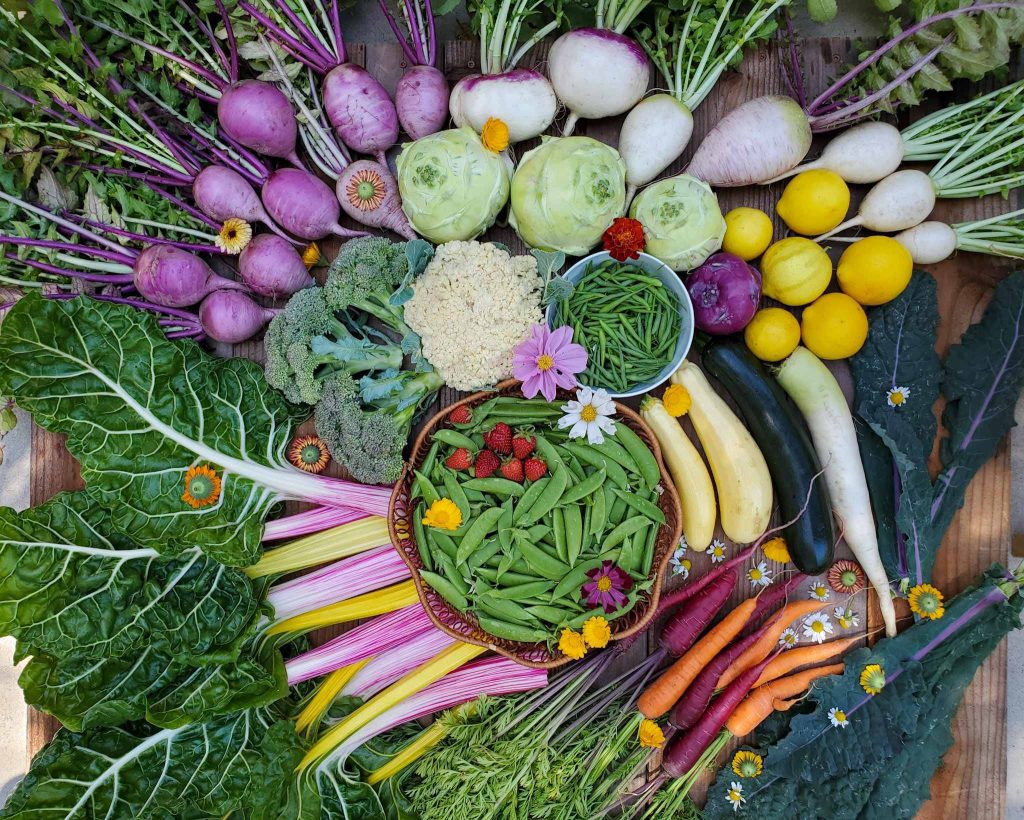Seasonal Harvesting: How to Plan Your Garden for Year-Round Freshness

Unlocking the Secret to Year-Round Freshness
Gardening is more than a seasonal hobby; it’s an art that can provide fresh produce throughout the year. By understanding the principles of seasonal harvesting, you can transform your garden into a continuous source of fresh fruits and vegetables. The right planning sets the foundation for a garden that thrives in all seasons, offering bountiful yields regardless of the weather outside.
Here are some key components of effective seasonal harvesting:
- Crop rotation: This practice involves changing the type of crops grown in a particular area of your garden each season. It prevents soil depletion, as different plants utilize varying nutrients. For instance, leguminous plants like peas and beans can replenish nitrogen in the soil, making it ready for heavy feeders like tomatoes and corn in the next cycle. This not only improves soil health but also helps to reduce pest populations that tend to build up when the same crops are planted repeatedly.
- Companion planting: Certain plants have the ability to enhance each other’s growth when planted together. For example, marigolds are known to repel nematodes, making them great companions for vegetables like cucumbers. Additionally, herbs like basil can boost the flavor and growth of tomatoes when planted in close proximity. This strategic intercropping can lead to healthier plants and, consequently, a more productive garden.
- Variety selection: Choosing a diverse range of crops is vital to ensure that you have harvests at different times throughout the year. Opt for early-blooming vegetables like radishes and spinach to kick off your spring, while late-season crops such as butternut squash and kale can thrive into the fall and winter months. Mixing varieties also adds interest to your garden with an array of colors and textures.
Planning is crucial, particularly as seasons shift from chilly winters to balmy summers. By timing your plantings and harvests correctly, you can enjoy:
- Freshly picked vegetables, herbs, and fruits in every season. Imagine harvesting juicy strawberries in early summer or enjoying roasted root vegetables in winter.
- A vibrant garden filled with color and life, even in colder months. Winter gardens can feature bright greens like kale and vibrant pansies that not only survive but thrive.
- Reduced grocery bills and a healthier lifestyle through homegrown produce. Fresh, organic vegetables from your garden can lead to better dietary choices and fewer trips to the supermarket.
With careful preparation and a little knowledge, the dream of a garden producing fresh food year-round can become your reality. As you consider your next steps, take time to research local planting calendars and discover the unique climate of your region, as these will guide your planting choices.
Keep reading to uncover practical strategies for glancing at each season’s unique offerings and how to plan your garden accordingly. The journey to a flourishing, year-round garden awaits!

DISCOVER MORE: Click here for resilient plant options perfect for busy gardeners!
Understanding Seasonal Planting and Harvesting
In order to master the art of seasonal harvesting, it’s essential to understand the dynamics of planting and harvesting throughout the entire year. A gardening plan that aligns with the local climate and seasonal cycles allows you to optimize yields while ensuring a steady supply of fresh produce. This notion hinges on two main factors: timing and selection.
One of the first steps to establishing a year-round garden is creating a detailed planting schedule that reflects the climate of your region. For instance, those residing in the warmer southern states may have the luxury of planting and harvesting a wider range of crops all year, while gardeners in northern areas may need to focus on cold-hardy varieties and protect their plants against frost. As you plan, consider the following:
- Know Your Hardiness Zone: The USDA Plant Hardiness Map divides the country into zones based on climate. For example, zones 3-4 experience harsh winters, while zones 8-10 enjoy mild winters. Understanding your zone can guide your choices in variety selection and planting times.
- Follow Frost Dates: Familiarize yourself with the last frost date in spring and the first frost date in fall for your area. This knowledge will help you schedule your plantings to avoid frost damage, ensuring that crops like zucchini and sweet corn are planted at the optimal time.
- Season Extension Techniques: Implementing techniques such as using cold frames, row covers, or hoop houses can extend your growing season. These setups provide protection from harsh weather while allowing you to continue harvesting during late fall and early spring.
With these practical tips in mind, knowing when and how to plant the right varieties is essential for maximizing your garden’s potential. A well-planned garden can feature:
- Succession Planting: This technique involves planting a new crop immediately after harvesting an earlier crop, effectively filling gaps in production. For example, once your spring lettuce has been harvested, you can plant a late summer round of beans in the same bed for continuous yields.
- Intercropping: This strategy allows you to grow multiple crops in proximity for maximum utilization of space and resources. Planting fast-growing crops like radishes alongside slower crops like carrots can ensure a more efficient use of soil and nutrients.
- Seasonal Favorites: Consider incorporating beloved seasonal vegetables such as asparagus, which can flourish for years, and herbs like thyme and rosemary, which thrive in both summer and winter conditions.
By putting these methods into practice, you’ll find that each season offers its own unique set of crops, leading to a vibrant and fruitful garden. As you deepen your understanding of seasonal planting, you’ll be better equipped to make informed decisions that foster a flourishing garden throughout the year, satisfying not just your culinary cravings but also contributing to a sustainable lifestyle.
| Category | Benefits and Features |
|---|---|
| Crop Rotation | Enhances soil fertility and prevents disease buildup. |
| Seasonal Planting | Maximizes harvest times and ensures a diverse crop yield throughout the year. |
| Companion Planting | Promotes healthy growth through natural pest control and nutrient sharing. |
| Soil Improvement Techniques | Organic matter and mulching enrich soil health, retaining moisture effectively. |
To achieve the best results in your garden, understanding the principles of seasonal harvesting is vital. Both crop rotation and seasonal planting work in synergy, allowing you to maximize your yield and keep your garden thriving throughout the year. With crop rotation, you can maintain soil vitality, controlling pests and diseases naturally while boosting nutrient levels in the ground. Moreover, by carefully planning your planting schedules, you ensure that there is a continuous supply of fresh produce, enriching your meals and promoting a healthier lifestyle.Additionally, employ companion planting techniques to cultivate plants that support each other’s growth. This not only minimizes the need for chemical pest control but also increases biodiversity. Techniques such as adding organic matter to your garden beds and using mulching can significantly enhance soil structure and moisture retention, making your plants less water-dependent. Explore these strategies further to uncover the comprehensive benefits of year-round gardening while ensuring an abundant, seasonal harvest at your fingertips.
DISCOVER MORE: Click here to learn how to enhance your home garden
Choosing the Right Crops for Each Season
Once you have a solid understanding of your planting schedule and techniques, the next pivotal step in achieving year-round freshness is to carefully select the right crops for each season. This is where your gardening dreams can become a reality, as the bounty of fresh produce varies remarkably with each passing month. By carefully considering which vegetables, fruits, and herbs flourish in your region, you’ll cultivate a garden bursting with flavor and nutrition year-round.
In the spring, as the soil begins to warm up, focus on planting cool-season crops that thrive in the moderate temperatures. Vegetables such as peas, spinach, and radishes can be sown as early as March in many areas. These crops are not only easy to grow but can also be harvested within a short period, providing a gratifying start to the gardening season. Additionally, don’t overlook the potential of herbs like cilantro and parsley, which can jump-start your culinary adventures.
As the temperatures rise, it’s time to shift your attention to warm-season crops. In most regions, the ideal time for planting summer favorites like tomatoes, cucumbers, and peppers begins around late May. These plants flourish under the sun and can yield an abundance of produce. However, be mindful of the need for adequate watering and mulching, particularly when the heat peaks in the summer months.
Fall brings with it a second opportunity for planting, as many gardeners often overlook the potential of autumn crops. Vegetables like kale, broccoli, and carrots can be sown late in the summer to enjoy a fruitful harvest through fall or even into winter with the right protection. Here, the use of row covers or cold frames can significantly extend the growing timeline, ensuring that your garden is not only productive but resilient against the oncoming chill.
Utilizing Companion Planting
Another clever tactic in crop selection involves companion planting—a practice that harnesses the power of synergy within the garden. Certain plants can benefit one another when planted together, enhancing growth while simultaneously deterring pests. For instance, pairing basil with tomatoes can improve flavor and yield while helping to repel common tomato pests. Similarly, planting marigolds throughout your garden can act as a natural deterrent for nematodes and aphids, creating a healthier environment for your plants to thrive.
Continuous Harvest Through Crop Rotation
To ensure that your garden is never short on fresh produce, consider implementing a crop rotation strategy. This technique goes beyond simply planting in succession; it involves changing the location of different crops in your garden each season to prevent nutrient depletion in the soil and reduce pest infestations. By rotating plants like legumes and brassicas, you can maintain a nutrient-rich growing environment that supports continuous harvests throughout the year.
With each season offering unique opportunities for gardening, the key lies in a thoughtful approach to crop selection. From springtime greens to summer staples and frost-hardy fall vegetables, judicious planning will ensure that your garden remains a prolific source of seasonal delights. As you continue to explore your local growing conditions and experiment with various crops, you’ll undoubtedly discover an array of flavors and textures that will elevate your culinary experience while contributing to a sustainable lifestyle.
DISCOVER MORE: Click here to learn about beginner-friendly plants
Conclusion: Embrace the Journey of Seasonal Harvesting
In summary, planning your garden for year-round freshness is both an art and a science that can transform your culinary experience while promoting sustainability. With a keen understanding of your local climate, thoughtful crop selection, and innovative techniques such as companion planting and crop rotation, you are equipped to optimize every growing season. Each time the garden changes from spring to summer and then to fall, embrace the unique possibilities it offers. The rewarding taste of freshly-picked tomatoes in summer or sweet carrots in late autumn can invigorate your meals and create an enduring connection to the Earth.
Additionally, as you grow your skill set, you’ll uncover a slew of diverse plants suited to your region. Explore the rich diversity of heirloom strains or organic methods that align with sustainable gardening practices. By continually experimenting and adapting to nature’s rhythms, your garden will not only produce bountiful harvests but also be a source of personal growth and fulfillment.
So roll up your sleeves, tap into your green thumb, and embark on the thrilling adventure of seasonal harvesting. Whether you are a novice enthusiast or an experienced gardener, there is always more to learn and discover. Your unique garden awaits—ready and full of potential to bring fresh, nutritious delights to your table, no matter the season.



